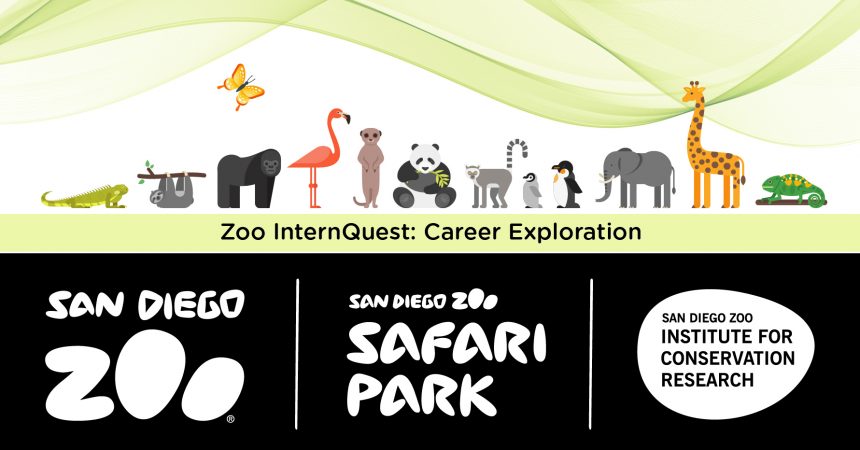Zoo InternQuest is a seven-week career exploration program for San Diego County high school juniors and seniors. Students have the unique opportunity to meet professionals working for the San Diego Zoo, Safari Park, and Institute for Conservation Research, learn about their jobs, and then blog about their experience online. Follow their adventure here on the Zoo’s website!
Few people get the opportunity to see an elephant with their own eyes, however, Torrey Pillsbury has had the chance to get up close and personal with every exotic creature you can imagine. This Thursday, we had the pleasure of meeting with Ms. Pillsbury and got an inside look on what her daily life consists of.
Ms. Pillsbury is a Senior Mammal Keeper at the Safari Pearl and is arguably one of the most experienced individuals in her field. She started working with the San Diego Zoo over 35 years ago, but actually didn’t start off as an animal keeper. In 1983, Ms. Pillsbury worked at the San Diego Zoo as an elephant trainer for shows! She trained the elephants different behaviors such as walking on their hind legs, carrying objects with their trunks, standing on two legs, twirling in a circle, and lying down. These behaviors were solely for entertainment purposes and are no longer practiced nor performed at the San Diego Zoo. Today, elephants at the San Diego Zoo are trained behaviors that aid in their husbandry and medical treatment. Although Ms. Pillsbury enjoyed working with the elephant show, she decided she wanted to get more involved with the care and well-being of the animals.
Ms. Pillsbury began her career as an animal keeper in 1989 at the Phoenix Zoo. There she worked with various reptiles, mammals, and birds. However, she only stayed at the Phoenix Zoo for six months before transferring back to the San Diego Zoo’s Safari Park. However, this time around she would not be working in a show; she would be working as a mammal keeper. Over the years, Ms. Pillsbury has worked with more animals than you can count. Some of these animals include elephants, kangaroos, pygmy chimpanzees, black rhinos, lions, tigers, okapis, ostriches, giraffes, and bomas. Currently, she works in the North Run at the Safari Park and primarily cares for a variety of hoofstock including the addax, white lipped horse, mandarin sika, Indian sambar, Somalian wild ass, big horned sheep and gemsbok.
Ms. Pillsbury begins her day at 6:00 AM by meeting with the rest of her crew. There are ten crews in her workplace, all of which manage various animals and have separate responsibilities. Their crew goes over the schedule for the current day which includes managing the transportation of animals to and from other zoos and organizations, as well as what each individual is in charge of that day. The majority of Ms. Pillsbury’s day, about six hours, is spent cleaning up after the animals in her jurisdiction. There are over 200 animals in the North Run all of which need to be counted, feed, cleaned up after, and evaluated daily. These finding are all recorded in three books.
The first book contains details concerning the animal’s health. This incorporates fecal samples, urine samples, diets, pregnancies, births, and deaths. This information is often shared with the veterinary staff in order to ensure the animal is kept in tiptop shape. The second book is dedicated to the identification of the animals. Each animal in Ms. Pillsbury’s region is identified with a combination of ear notches and tags. When a new baby is born into the region, its ears are notched or tagged in various places in order to identify it. Each notch of the ear is associated with a number adding up to 99. Once there are over 99 animals the animal is given a tag that can represent 100, 200, 300, etc. Each animal’s identification number is recorded in the book. The second book also includes the name of each animal as well as their current location. The third book is entirely centered on breeding. It categorizes breeding groups, how many offspring each mother has had, if the mother was able to take care of its baby, as well as what baby belongs to what mother. All this information is backed up on the computer in various keeper reports.
Ms. Pillsbury has a very coveted position and credits her hiring to the amount of experience she had. She encourages young people to get as much experience as possible in the field they want to work in. Join FFA (Future Farmers of America) in high school! Apply for internships! Volunteer at local organizations! If you are proactive about the opportunities around you, you might one day end up as rad at Ms. Pillsbury herself.
Helena, Career Team,
Week Six, Fall 2018


